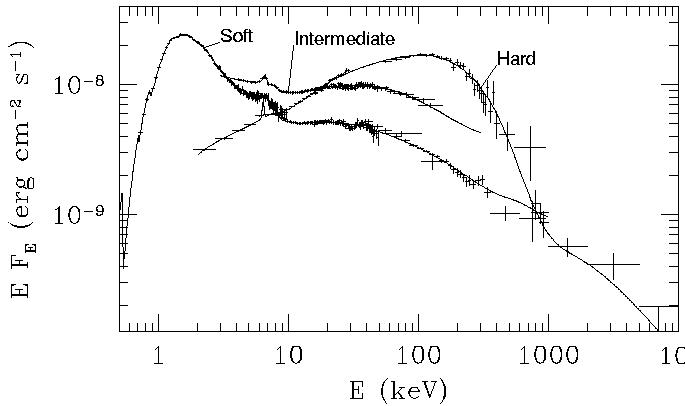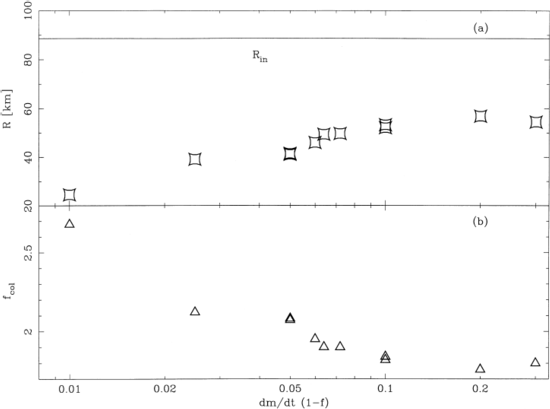
Figure 1: The three spectral states of Cygnus X-1
Introduction
An X-ray binary is supposed to harbor a black hole when the dynamically established mass of the primary exceeds the upper theoretical limiting mass for a neutron star (which is, at most, around 3 solar masses), or when its spectral and timing properties are similar to those of a dynamically selected black hole candidate (BHC).
Black hole candidates are observed in different spectral states. The definition of the different states is made in term of their spectral component and flux level (typically in the 1 - 10 keV band) (see Zdziarski 2000 for a recent review). The two main states are:
- The Hard/Low state, in which the sources emit most
of their power in a hard power law tail with photon index
Gamma ~ 1.3 - 1.7 and an exponential cut-off is observed at about 100
keV.
- The Soft/High state, generally more luminous,
in which most of the energy comes from a thermal component with characteristic
temperature kT <1 keV while a power law component (with Gamma ~ 2.0
- 2.5) dominates above few keV.
In addition, sources have been reported to be in a Very High state, spectrally intermediate between the Soft/High and the Hard/Low, when power law component has a flux comparable to the thermal one and no sign of cut-off is seen in the high energy tail (see Figure 1).

Figure 1: The three spectral states of Cygnus X-1
The ultra-soft, thermal component is usually regarded as the signature of the presence of an optically thick accretion disc. The standard picture is the one developed in the classical paper by Shakura and Sunyaev (1973) for a Newtonian disc, and by Novikov and Thorne (1973) for a relativistic one.
Standard so-called Shakura-Sunyaev accretion discs are the starting point for the interpretation of the soft spectral components of black hole binaries in terms of black hole parameters. In fact, the simplest model used to fit the data, the Multicolour Disk Model (MCD), neglects the disc vertical structure and the radiative transfer properties of such a system; nevertheless, thanks to its simplicity, it is widely used to interpret observations.
Results: the multicolour model and the inner radius of the accretion disc
In our work (Merloni, Fabian & Ross, 2000)
we have discussed and applied a number of corrections to this model, which
take into account vertical structure and radiative transfer to build
more realistic models, and demonstrate how these corrections lead
to major uncertainties in the interpretation of the MCD spectral fits (see
Figure 2).

Figure1: The main results presented in Merloni, Fabian
& Ross (2000):
we have fixed the inner radius of an accretion
disc at the value
appropriate for a 10 solar masses Schwarzschild
black hole
(88.6 Km, solid horizontal line).
The power viscously dissipated in the disc varies
along the X-axis.
In the upper panel we plot the value of the inner radius
one would obtain
from a simple multicolour fit without taking
into account vertical temperature
structure and Comptonization in the upper layers
of the disc.
Clearly the value of the inner radius is underestimated
by up to a factor of four, for very
low accretion rate (dm/dt) and/or very powerful coronae
(as measured by the parameter f).
In the lower panel we plot the hardening factor
needed to rescale the MCD fitted
parameters to the actual values. It is worth stressing
that the value
of the hardening factor is usually assumed to be f~1.7.
This point is of particular importance because one of the main pieces
of information one can obtain by means of these fits is the inner disc
radius.
In turn, the knowledge of the inner boundary of the disc tells us about
two fundamental properties of the accreting system:
(a) if we believe that the inner disc is not disrupted
by some kind of instability, as is likely the case in the Soft state,
we could know where the innermost stable orbit around the black hole is
located, and, consequently, how massive the hole is and which is its spin;
(b) alternatively, we could establish where the transition
to a different (geometrically and radiatively) accretion process (for example
to an advective flow)
takes place and gain a better understanding of the nature of the accretion
process itself.
This kind of diagnostic is becoming an important tool in the field, and inferred values of black hole masses or even spins obtained from inspection of BHC spectra, can be found in the literature. They have, anyway, to be handled with care, for the reasons described in our work.
Current work
We are extending our model for the accretion disc spectra to the rotating black hole case and to include general relativistic effects. The rotation of the hole is a key ingredient for all the cases in which the disc extends down to the innermost stable orbit, because the actual location of the inner disc depends on the black hole spin. Since most of the accretion energy is liberated in the inner regions, high spectral resolution observation of black hole candidates in the Soft state could provide us with the first direct estimate of a black hole angular momentum.